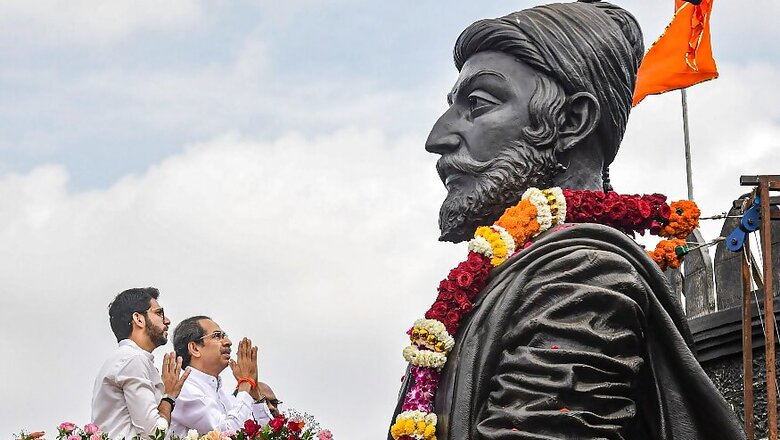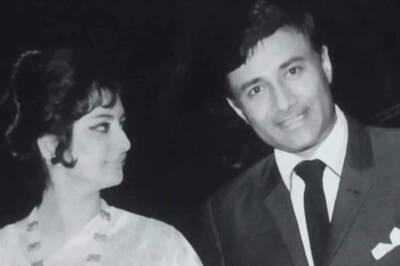
views
There are few examples of a cartoon weekly catalysing the formation of a pre-eminent political movement.
But launched in August 1960, Marmik, the first Marathi political cartoon weekly run by cartoonists Bal Thackeray and his younger brother Shrikant did just that, by birthing a political party based on a nativist political agenda.
At 9:30 am on June 19, 1966, Sahadeo Naik, a family friend of the Thackeray’s broke a coconut before Chhatrapati Shivaji Maharaj’s bust in their flat at Dadar in Mumbai, marking the launch of the Shiv Sena. This was the culmination of the weekly’s campaign voicing apprehensions about discrimination against Marathi-speaking youth when it came to getting employment opportunities.
However, 54 years since it was launched, the Shiv Sena is standing on a cusp of a make-or-break opportunity.
Today, Shiv Sena president Uddhav Thackeray has been catapulted to the chief minister’s chair in a culmination of circumstances that would have seemed improbable around a year ago.
The Thackerays have traditionally stayed away from positions of power to maintain the halo of a renunciation around them. In 1995, when the Shiv Sena- BJP alliance came to power in Maharashtra, the late Shiv Sena supremo Bal Thackeray chose to nominate Manohar Joshi, and later, Narayan Rane as the chief ministers, and called himself the regime’s “remote control”.
However, this diarchy of power was fraught with its own tensions and contradictions, and led to Joshi’s ouster and replacement by Rane (1999), and later, Rane’s shift to the Congress from the Sena (2005).
Often mistakenly referred to as a “reluctant politician”, Uddhav who fought off challenges from dissidents like Rane, and his estranged cousin Raj Thackeray, who launched the Maharashtra Navnirman Sena (MNS) in 2006, indicated that he wanted a more hands-on role.
His elder son and Yuva Sena chief Aaditya was the first from the Thackeray family to seek public office by contesting and winning the assembly elections from Worli in Mumbai. He is now the environment and tourism minister in his father’s coalition government.
However, as a party which has a single family as the fulcrum, the leadership’s transition into electoral politics and government is a double-edged sword. These dilemmas go much beyond the Shiv Sena’s expedient, unlikely alliance with the Congress and Nationalist Congress Party (NCP) and questions about the longevity of the government.
With the organisation and government being controlled by one individual or family and their esoteric circle, the performance of the Shiv Sena-led regime will have a deep impact on the fortunes of the party and its perception, even among loyalists.
The ability of the Thackerays to govern and rule as heads of a government was a closed fist, the contents of which were a well-kept secret. As chief minister, Uddhav’s performance will be put under the scanner, and this will expose him and the Shiv Sena to criticism and debate, especially as the state grapples with the Covid-19 pandemic and its aftermath.
Unlike the NCP or the Congress, the Shiv Sena has not bothered to cultivate a cadre of loyal officers and bureaucrats. The Sena has chosen instead to focus on the politics of the cash-rich Brihanmumbai Municipal Corporation (BMC), which it has controlled for over three decades, without having to show much in terms of performance.
Already, growing murmurs within the Shiv Sena’s ranks claim that the NCP calls the shots in the government, with deputy chief minister Ajit Pawar pulling the strings to ensure that his party men get their way at the grassroots. This often puts the NCP in conflict with the Shiv Sena, as the two share an overlapping support base and area of authority. The NCP has cornered the prime portfolios in the government, creating a perception that the Shiv Sena is in power, but not in authority.
It is also claimed that Uddhav is bringing his brand of ‘darbari’ or coterie style politics to the government, leading to resentment.
The Shiv Sena’s other weakness is the shrinking number of Maharashtrians — its main support base — in Mumbai and surrounding areas.
Though the urbane, suave, well-spoken Aaditya has been tasked with reaching out to a cosmopolitan crowd, most Shiv Sena veterans agree that the tight-rope walk lies in creating an auxiliary constituency without estranging the core vote-base. This is because the interests of the Shiv Sena’s rough-and-ready working class supporters, who are drawn from the lower and middle class of society, rarely converge with those from the upper-crust, whom the Sena’s Next-Gen leadership is seeking to attract.
The Shiv Sena is also seen as undergoing an era of “Congressisation” or a process of stagnation that restricts upwards mobility for fresh blood within the organisation.
The party, which has developed an urban-feudal outlook, is also unable to strike new social and caste coalitions to expand its base and strike new alliances, using the lure of power and patronage. This is unlike the NCP, which moved fast to reach out to erstwhile foe and farmer leader Raju Shetti, whose Swabhimaani Paksha, has a base in sugarcane cultivators and dairy farmers. The BJP, too, has been trying to nurture an alternate other backward classes (OBC) leadership, often at the cost of its established faces.
Hence, with the party and its chief now part of the government, the Shiv Sena’s future as an organisation may be linked to the performance of its regime.




















Comments
0 comment